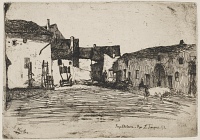Etchings Institutions search term: flemish gallery
Liverdun | ||
| Number: | 13 | |
| Date: | 1858 | |
| Medium: | etching | |
| Size: | 109 x 156 mm | |
| Signed: | 'Whistler' at upper right (1-final); 'J. Whistler' at lower left (3) | |
| Inscribed: | 'Imp. Delatre. Rue St. Jacques. 171.' at lower right (3) | |
| Set/Publication: | 'French Set', 1858 | |
| No. of States: | 3 | |
| Known impressions: | 48 | |
| Catalogues: | K.16; M.16; T.2; W.4 | |
| Impressions taken from this plate (48) | ||
KEYWORD
animal, cart, cow, farm, farmyard, hayrack, house, ladder, people, square, town.
TITLE
Both Whistler and his cataloguers always called this 'Liverdun'. Examples are as follows:
'Liverdun' (1858, Whistler). 1
'Liverdun' (1870s, Whistler). 2
'Liverdun' (1874, Ralph Thomas, Jr (1840-1876)). 3
All later cataloguers also used the same title, 'Liverdun'.
'Liverdun' (1858, Whistler). 1
'Liverdun' (1870s, Whistler). 2
'Liverdun' (1874, Ralph Thomas, Jr (1840-1876)). 3
All later cataloguers also used the same title, 'Liverdun'.
DESCRIPTION
A sloping farmyard is surrounded by asymmetrical farm buildings, with uneven tiled roofs, and small windows, one with open shutters. Ladders, a cart and other farm implements lean against a wall at left, figures sit and stand in the shade at right (where a big archway leads out of the yard), and a white cow walks downhill to right.
SITE
Liverdun is a small town on the river Moselle, in the district of Meurthe et Moselle, in Alsace-Lorraine in north-eastern France. It is north-west of Nancy and would have been among the earliest stops on Whistler's train journey from Nancy to Strasbourg. After Liverdun he went on to Maladrie, Lutzelbourg and Saverne. Whistler ignored the ruined fortifications, Medieval and Renaissance buildings and drew instead the old farm buildings around a square.
DISCUSSION
This was the first etching in the prospectus for the 'French Set' and asserts the importance of working from nature, as indicated by the series title, Douze eaux-fortes d'après Nature.
Lochnan points out that this etching may have been the first done from nature on the Rhine trip, and 'reveals a debt to Jacque and to the seventeenth century Dutch etching tradition.' 4
Charles Jacque (1813-1894) certainly influenced Whistler's choice of subjects and development of technique, as did a close study of Dutch etchers, in particular Rembrandt Harmens van Rijn (1617-1681).
4: Lochnan 1984 , p. 38.

